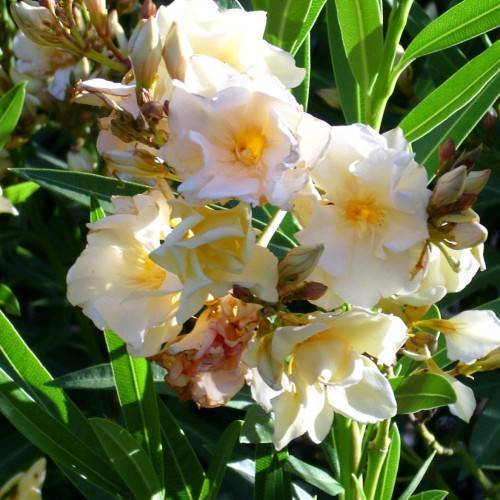
oleander
Nerium oleander 'Luteum Plenum'
Also Known As - rose bayCycle:
Perennial
Watering:
Average
Hardiness Zone:
8 - 10
Flowers:
Flowers In Summer
Sun:
Full sun
Soil:
Humus rich, Well-drained
Fruits:
Fruits In Autumn Ready In Summer
Leaf:
Yes
Growth Rate:
High
Maintenance:
Low
Poisonous To Humans:
Yes
Poisonous To Pets:
Yes
Drought Tolerant:
Yes
Salt Tolerant:
Yes
Invasive:
Yes
Care Level:
Medium
watering
Oleander should be watered deeply about once a week with 1-1.5 inches (2.5-3.75 cm) of water. Soak the soil to a depth of 8-10 inches (20-25 cm). During periods of dry weather, more frequent deep watering may be necessary. Allow the soil to dry slightly between waterings, but never let the soil dry out completely or become drenched. Avoid overwatering, which can lead to root rot and other diseases.
sunlight
Oleander (Nerium oleander 'Luteum Plenum') is a plant species that prefers full sun exposure for optimal growth and blooming ability. Ideally, this plant should receive at least 6 hours of direct sunlight per day. When possible, try to place the oleander in an area with full, direct sun in the morning and some light shade in the afternoon or late afternoon, as this will provide the ideal lighting conditions. In areas with intense midday light, filtered sun or light shade in the afternoon may be a better choice for success. However, oleander can also tolerate partial shade from trees or buildings if necessary. When growing oleander, consider where the sun exposure will be throughout the day and season and pick a spot well-suited for the plant's needs to ensure optimal growth and health.
pruning
Oleander (Nerium oleander 'Luteum Plenum') should be pruned twice a year, in late spring and late summer. Pruning should be done lightly to maintain the plants natural shape and size. In late spring, lightly prune dry, dead branches, removing up to 1-third of the plants growth to keep its size in check. In late summer, remove spent blossoms as well as any rogue shoots that have grown too large. Pruning will improve the overall health of oleander and encourage more abundant blooms.
